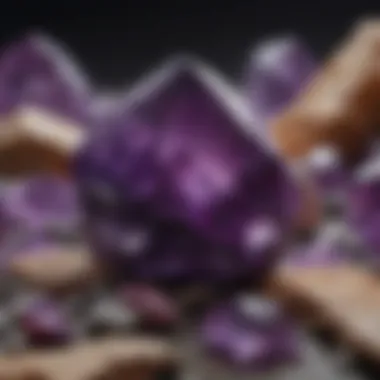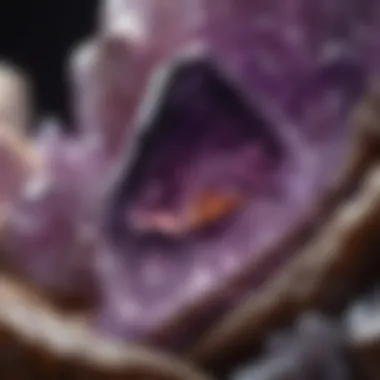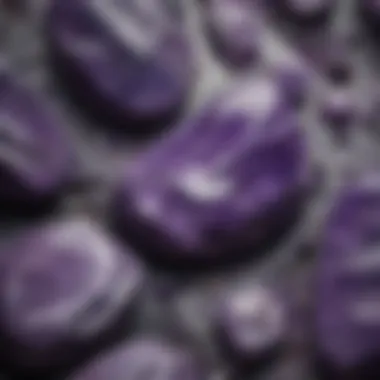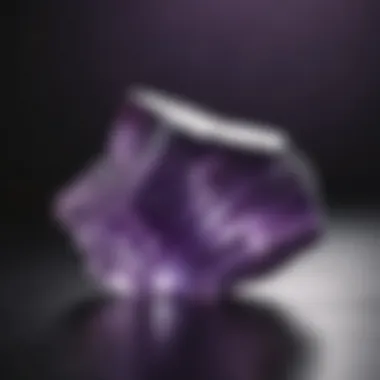Exploring the Fascinating World of Purple Crystals


Intro
Diving into the stunning world of purple stones and crystals is like peeling back the layers of a beautifully wrapped gift. Each layer reveals something different—geological marvels forged through time, rich cultural narratives, and unique properties that allure both seasoned enthusiasts and newcomers alike. From the depths of amethyst to the rare beauty of charoite, purple minerals offer a spectrum of exploration for collectors and aficionados. Together, we will navigate these vibrant stones, piecing together their origins, their distinct attributes, and the role they play within various cultures.
Topic Overview
Definition of Purple Stones and Crystals
Purple stones and crystals typically refer to minerals that exhibit this captivating hue due to specific elements and conditions during their formation. These can encompass a range of gemstones such as amethyst, sugilite, and charoite. Each stone possesses its own complex makeup, contributing to both its aesthetic appeal and its classification within geology.
Brief History and Significance
Historically, purple stones have been associated with royalty, spirituality, and healing. The deep purple of amethyst was once reserved for the likes of kings and queens because it was believed to signify power and protection. Throughout the ages, these minerals have not only been valued for their beauty but have also held significant places in various cultural practices—amethyst in psychic abilities, charoite in personal transformation, and so on. This historical context provides a valuable backdrop for understanding how such stones resonate with human experience and emotion.
Identification and Classification
How to Categorize Purple Stones
When it comes to identifying and classifying purple stones, it's essential to consider several key factors:
- Color: The shade of purple can vary from light lavender to deep violet.
- Clarity: Some stones are more transparent than others; for instance, high-quality amethyst is typically quite clear.
- Hardness: Utilizing the Mohs scale can help determine how resistant a stone is to scratches, with amethyst having a hardness of about 7.
- Luster: This refers to how light reflects off the surface of the stone; purple stones can exhibit vitreous (glass-like) or pearly luster.
Tips for Identifying Key Features
To get the most from your collection endeavors, consider these tips:
- Examine Under Light: Natural light can highlight color variations and flaws that aren't visible under artificial light.
- Use a Loupe: A jeweler's loupe or magnifying glass can help you spot inclusions or unique patterns.
- Compare Textures: Rubbing the stone gently against your skin can help assess its texture; some crystals feel smoother than others.
"Understanding the subtle differences between purple stones isn't just about collecting; it is a way of connecting with their stories and the earth."
Being mindful of these attributes not only enhances your collecting experience but also deepens your appreciation of the geological wonders at play. As we journey deeper into the captivating facets of purple stones and crystals, expect to uncover even more amazing insights.
Prolusion to Purple Stones and Crystals
The realm of purple stones and crystals captivates many with their rich hues and multifaceted properties. Throughout history, these stones have been cherished for not just their beauty, but for their supposed metaphysical qualities and their place in various cultures. Understanding these elements can enhance the appreciation for collectors and enthusiasts alike, making them an important part of any gem and mineral exploration.
The Allure of Purple
The color purple has long been associated with royalty and spirituality. Its varied shades—from the soft lavender of amethyst to the deeper tones of charoite—draw the eye and stir the soul. Purple stones are unique not only for their vibrant colors but also for their perceived healing powers and mystical connections. For admirers, these characteristics turn ordinary geological specimens into treasured items of personal connection and purpose.
The distinctiveness of these stones allows for endless exploration. Each type has its own story, often steeped in historical beliefs about healing and protection. To collect them is to collect history, artistry, and a piece of nature itself.
An Overview of Geological Formation
Understanding how purple stones achieve their striking appearance is key to appreciating their value. Most of these gems are formed through intense geological processes over millions of years.
- Amethyst, for instance, originates from volcanic activity, forming when silica and iron combine in the earth's crust’s cooling magma. The presence of iron gives the stone its vibrant purple color.
- Fluorite typically forms in hydrothermal veins or sedimentary deposits, showcasing impressive color variations depending on impurities present during its formation. This makes every piece of fluorite one-of-a-kind.
- Charoite has its origins in the metamorphic processes, a result of the alteration of silicate minerals, creating striking patterns that are rarely replicated.
The geological origins of these stones not only add to their uniqueness but also inform collectors about their value and rarity. Knowing where and how these beautiful specimens were formed allows collectors to better appreciate not just their aesthetics but their scientific significance and the stories they carry.
Key Types of Purple Stones


Understanding the key types of purple stones is like opening a treasure chest of nature’s artistry. Each stone tells a story—its own layer of geological history, and offers different benefits. This section prepares us to navigate through the unique characteristics that define these stones and gives us a strong foundation. Any enthusiast knows that distinguishing features not only enhance collecting but also serve as conversation starters in core discussions about geology and culture.
Amethyst
Properties and Composition
Amethyst stands out because of its remarkable composition. Formed primarily from quartz, amethyst gets its stunning purple hue from iron impurities and natural radiation over time. This crystal is not just visually appealing—its energy is often described as soothing and protective. The ability to amplify positive energy while dispelling negativity earns it a revered place in both the jewelry and metaphysical worlds. Amethyst is a popular choice for collectors due to its accessibility and broad range of colors, from pale lavender to deep purple, contributing to its desirability.
Historical Significance
Historically, amethyst has played a pivotal role in various cultures. The ancient Greeks believed it could temper intoxication; thus, they wore it as a talisman. Beyond its ornamental value, it served as a symbol of power and authority among church leaders in the Middle Ages. This connection to spiritual leadership adds a layer of significance that remains relevant today. Collectors often appreciate how its rich background complements their pieces, allowing them to own not just a stone, but a slice of history.
Varieties of Amethyst
The varieties of amethyst further enrich its allure. From Brazilian amethyst, known for its deep color, to the lighter shades found in African stones, each has distinct traits. One notable variety is the Ametrine, which combines amethyst and citrine. This blend not only offers aesthetic beauty but is also prized in energy work for balancing yin and yang. Variability in quality affects its collectible value, adding another layer to the collector’s hunt.
Fluorite
Color Variations and Uses
Fluorite’s charm lies in its vibrant colors, which range from deep purple to blue, green, and even clear. Each hue often reflects different mining locations and methods of creation. This diversity makes fluorite popular for a variety of uses, including in crystal healing necklas as its vibrant colors are visually stunning. Moreover, many collectors love to showcase these visually striking stones in their homes. Different color variations can signal different healing properties, giving each piece an added layer of significance.
Optical Properties
What sets fluorite apart are its unique optical properties. Recognized for its fluorescence, under ultraviolet light, fluorite can display a dazzling glow. This characteristic not only makes it fun to examine but also makes it an essential mineral for certain industrial uses such as in the making of lenses and optics. Understanding these traits broadens a collector's appreciation, showcasing how physical properties contribute to the overall value.
Mining Locations
Fluorite is mined in various locations, each contributing to its unique characteristics. China, Mexico, and the United States house notable deposits, each producing different varieties. For a collector, knowing where a piece originated can add to its value and relevance. For instance, the historic mines in Illinois yield rare specimens treasured by many. The mining process and location can tell stories that elevate the rock beyond a mere collectible—transforming it into a piece of geological significance.
Charoite
Unique Visual Characteristics
Charoite captivates with its swirling patterns of lavender and purple, often veined with black or white. This unique visual presentation draws collectors who are looking for something exceptional. Known for its mystical appearance, charoite is a relatively rare stone, making it highly sought after. Its visual impact transcends mere aesthetics—it often inspires creativity and promotes personal transformation, ideal for people who appreciate both art and symbolism in their collections.
Place of Discovery
Discovered in Siberia, charoite is notable for its exclusive origin. Its unique geological formation, found near the Chara River, means that collectors often seek it as a symbol of rarity. This adds a narrative quality to any piece, enriching the experience of ownership. The region's remote location emphasizes its exclusivity, which intrigues collectors and can drive price points higher.
Collectible Value
The collectible value of charoite is linked strongly to its rarity. Since it can only be found in specific regions, especially in Siberia, the variability in yield contributes to scarcity. With growing interest in unique crystals, the value may appreciate as more people seek to own this striking gemstone. Collectors often emphasize the importance of authenticity and quality to ensure they invest in pieces that hold significant aesthetic and historical value.
The Metaphysical Properties
The metaphysical properties of purple stones and crystals carry significant weight in both new-age practices and traditional beliefs. These stones are often seen as bridges to deeper states of consciousness and emotional balance. Within the context of this article, understanding these properties provides insight into how purple stones not only captivate through their visual appeal but also through their perceived energetic benefits. Special attention is often given to stones like amethyst and fluorite, where their associations with spirituality and healing make them popular choices among collectors and practitioners alike.
Spiritual Connections
Amethyst in Meditation


Amethyst stands out in meditative practices not just as a pretty stone but as a tool that many believe enhances one's spiritual journey. This deep purple crystal is renowned for its calming energy, often facilitating a tranquil environment that can deepen meditation experiences. The unique feature of amethyst in meditation is its purported ability to help clear the mind, allowing for a more profound introspective journey. This quality makes it a beneficial choice for those seeking to manage anxiety or stress while exploring personal insight.
However, some practitioners caution that too strong an attachment to amethyst could lead one to become overly reliant on the stone instead of fostering one's inner strength independently.
"The calming essence of amethyst creates a peaceful haven for the mind—perfect for those seeking clarity."
Fluorite and Intuition
Fluorite is another crystal that garners significant attention for its association with intuition. Its various colors are believed to stimulate different aspects of mental capacity, making it a useful stone for enhancing decision-making skills and intuitive insight. What sets fluorite apart is its unique ability to ground chaotic thoughts, helping individuals gain clarity in uncertain situations. This quality positions fluorite as a popular choice for intuitive development and personal growth. However, like other crystals, overly relying on fluorite might limit one's own ability to tap into intuition without external aids.
Healing Properties
Emotional and Physical Healing
The concept of healing is multifaceted, and purple stones are often linked with both emotional and physical healing properties. Amethyst, specifically, is said to assist in emotional healing by promoting spiritual wisdom and inner strength. Many enthusiasts highlight its key characteristic of soothing anxiety and fear, making it an advantageous choice for anyone coping with life's ups and downs. However, while it offers great benefits, some skeptics argue that relying solely on stones for healing could detract from seeking professional help for serious issues.
Energy Balancing
Energy balancing is another critical aspect associated with purple crystals. The belief is that these stones can help align and balance one's energy fields, ultimately leading to enhanced vitality and well-being. For instance, people often turn to amethyst during times of emotional turmoil to regain stability. The unique feature of energy balancing in this context is its ability to harmonize conflicting emotions, aiding in clearer emotional expression. This beneficial quality can sometimes come hand-in-hand with the disadvantage of fostering dependence on crystals instead of promoting innate self-healing capabilities.
As we explore the multifaceted world of purple stones, it becomes clear that understanding their metaphysical properties enriches our appreciation and practical application of these remarkable gifts from the earth.
Caring for Purple Stones
Caring for purple stones is more than just maintenance; it’s about preserving their beauty and enhancing their longevity. Collectors and enthusiasts alike should recognize that these gems are not just beautiful but also delicate. Proper care can prevent dullness, scratches, and other forms of deterioration that can minimize their appeal. When one understands the ways to clean and store these stones, it becomes clear that taking the time for such practices can significantly increase not just the visual allure but also the value of the collection.
Cleaning and Maintenance
Recommended Practices
When it comes to cleaning purple stones, gentleness is key. One highly regarded method is to use warm soapy water with a soft cloth. It’s a simple yet effective method. Synthetic solutions or rough sponges can erode the stone's surface over time, taking away that cherished shine.
The main advantage of this practice is that it is cost-effective and easy to implement. Unlike chemical cleaners that can pose risks to organic and delicate stones, soapy water is gentle yet efficient. A distinct characteristic of this method is that it avoids harsh abrasives that could scratch or cause irreversible damage.
Though this practice sounds straightforward, collectors sometimes overlook it in the busy pace of life, causing stones to accumulate dirt and grease that are harder to remove later. Making this a regular routine keeps their stones looking vibrant.
Common Mistakes to Avoid
One common pitfall among collectors is the use of bleach or harsh chemicals. Many believe that stronger means better, but in the case of cleaning purple stones, this couldn’t be further from the truth. Using such substances can lead to fading or discoloration, effectively ruining what was once an excellent piece.
This mistake underscores the importance of education regarding gemstone care. The unique feature of avoiding these harsh chemicals is that it protects the structural integrity of the stones, enhancing both their aesthetic and material value.
Additionally, another blunder collectors might make is ignoring the specific cleaning needs of different types of stones. For instance, amethyst and charoite have different sensitivities, and thus employing a one-size-fits-all approach can lead to detrimental results.
Storing Your Collection
Ideal Conditions
Storing purple stones adequately is crucial for their preservation. Ideally, these treasures should be kept in a dry, stable location, away from direct sunlight and temperature fluctuations. Sunlight can cause vibrant colors to fade, and extreme temperatures can lead to cracking. Using a cloth pouch or a dedicated box lined with soft fabric can effectively minimize exposure and damage.
This kind of careful storage is beneficial because it not only enhances longevity but also inspires peace of mind for those who love their stones. One unique characteristic of such ideal conditions is that they prevent scratches that can occur from stones rubbing against each other.
Preventing Damage


Another vital aspect of caring for purple stones is actively preventing physical damage. This can be as simple as ensuring that they are stored separately, rather than tossed into a shared container. Using dividers or small compartments can help here. A key aspect of this approach is the awareness that certain stones can be more fragile and susceptible to scratches than others.
Implementing this strategy significantly helps maintain their original lustre. Moreover, preventing damage also involves being cautious during transport. Wrapping stones in soft cloths or bubble wrap when taking them out for a showing or sale can save them from unexpected accidents.
In summary, taking deliberate steps for both cleaning and storing purple stones not only maintains their physical beauty but also their intrinsic value. Engaging with your stones thoughtfully can significantly enhance your collection and the joy that comes with it.
The Role of Purple Stones in Culture
Purple stones and crystals have held a special place in human history and culture, manifesting their significance in various ways. From ancient civilizations to present-day artisans, these stones not only captivate the eye but also carry meanings and stories. Their beauty goes beyond aesthetic appeal, as they often symbolize spiritual qualities, status, and creativity across diverse cultures. This exploration highlights how purple stones weave through the fabric of societal beliefs and craftsmanship, helping us to appreciate their value beyond mere decoration.
Symbolism in Different Cultures
Ancient Beliefs
In ancient times, purple stones like amethyst were cherished for their beauty but also for their purported spiritual properties. Egyptians believed that amethyst protected its wearer from intoxication and promoted clarity of mind. In this sense, its deep violet hue was not just a visual allure but a guardian against the chaos of earthly desires. Its connection to the divine set it apart from ordinary stones; it was often associated with royalty and higher powers.
Moreover, the Greeks and Romans symbolized purple with wealth and status. Since purple dye was costly and rare, only the elite could afford garments colored with it. This made amethyst, a stone of purple, a fitting adornment for nobility, reinforcing its reputation as a stone of power.
The unique feature here is its dual role - as both a precious gemstone and a symbol of social hierarchy. The ancient beliefs, while reflecting the values of their time, also fostered a continuous appreciation for purple stones, enriching cultures through tradition and spiritual significance.
Modern Interpretations
Today, modern interpretations of purple stones echo the sentiments of the ancients but with a contemporary twist. Many view amethyst, fluorite, and charoite as not only beautiful but also as tools for emotional healing and energetic balance. In the fast-paced world of modernity, people turn to these stones seeking grounding and tranquility, recognizing their metaphysical properties in a new light.
An appealing aspect of this modern view is how it embraces a more personal connection with the stones. Practitioners of crystal healing often use them in meditation and mindfulness practices, believing that their vibrations affect mental and emotional states. The unique feature of this interpretation is its wide accessibility; anyone can explore the benefits of these stones without needing to be a part of the elite, thus democratizing their use.
This approach invites a more inclusive attitude toward the appreciation of purple stones, making them more than mere decorative items but treasures with potential for personal transformation and inner peace.
Applications in Art and Design
Gemstone Jewelry
Gemstone jewelry showcases purple stones in a variety of graceful forms. From the classic elegance of amethyst necklaces to the striking aesthetics of charoite rings, these pieces offer invaluable contributions to fashion and personal expression. Jewelers often choose purple stones for their rich colors and unique inclusions, which add character and depth.
A distinctive feature of purple gemstone jewelry is its ability to complement various skin tones and styles. Accessories crafted from these radiant stones provide more than just visual appeal; they also carry the weight of cultural symbolism. Many people don the jewelry not just for looks, but for the meanings behind these beautiful stones, often seeking to connect with their spiritual essence.
Decorative Uses
The uses of purple stones extend beyond jewelry into decorative arts. Home décor incorporating amethyst geodes or fluorite sculptures serves to enhance living spaces not just with beauty but with a sense of harmony. These stones are often employed in creating inspiring focal points in personal surroundings.
One advantage of utilizing purple stones decoratively is their striking energy. They are believed to promote creativity and enhance the atmosphere of the home. However, one disadvantage could be the price of high-quality specimens, which may limit accessibility for some individuals. Despite this, the investment can lead to a lasting sense of tranquility and elegance in any space.
Through both history and modern design, purple stones maintain an undeniable influence, proving their role as more than mere geological formations but rather as significant cultural artifacts that resonate with artistic creativity and personal significance.
Finale
When it comes to purple stones and crystals, the journey we’ve taken through this article reveals not just their external beauty, but a deeper and richer narrative that ties them to the earth, human history, and contemporary culture. The intricate layers of geological formation, unique metaphysical properties, and diverse applications in art and symbolic practices highlight their importance more than mere decorative objects.
Embracing the Beauty of Purple Stones
Embracing the beauty of purple stones goes beyond their visual appeal. These stones often resonate with those seeking balance, spirituality, and connection to nature. As collectors, you're not just acquiring objects; you're curating pieces that tell stories from ancient civilizations to modern spirituality. Take amethyst for instance; its deep violet tones have been associated with calming effects and enhanced intuition. The visuals speak to one’s aesthetic sensibilities, while their properties embody emotional and spiritual resonance. The charoite, with its swirling patterns, may attract those who appreciate its rarity and artistic appeal, making it a prized centerpiece in any collection.
Future Trends in Collecting
Looking ahead, the landscape of collecting purple stones is poised for evolution. The rise of online communities and platforms like reddit.com has empowered collectors, fostering knowledge sharing and expanding networks. Collectors are increasingly attuned to sustainability. With many eager to support ethical mining practices, stones with origins traced back to responsible sources are gaining popularity.
The focus might shift towards transitional markets, introducing new rarities and varieties. Man-made crystals are also entering the conversation as conversations about accessibility and affordability grow. Moreover, technological advancements in gem identification may offer unprecedented insights into authenticity and preservation, helping collectors make informed decisions.
In essence, as you embrace the beauty and significance of purple stones, stay attuned to the changes that lie ahead. Ultimately, these minerals allow for an ongoing dialogue between the universe, human creativity, and individual exploration.



